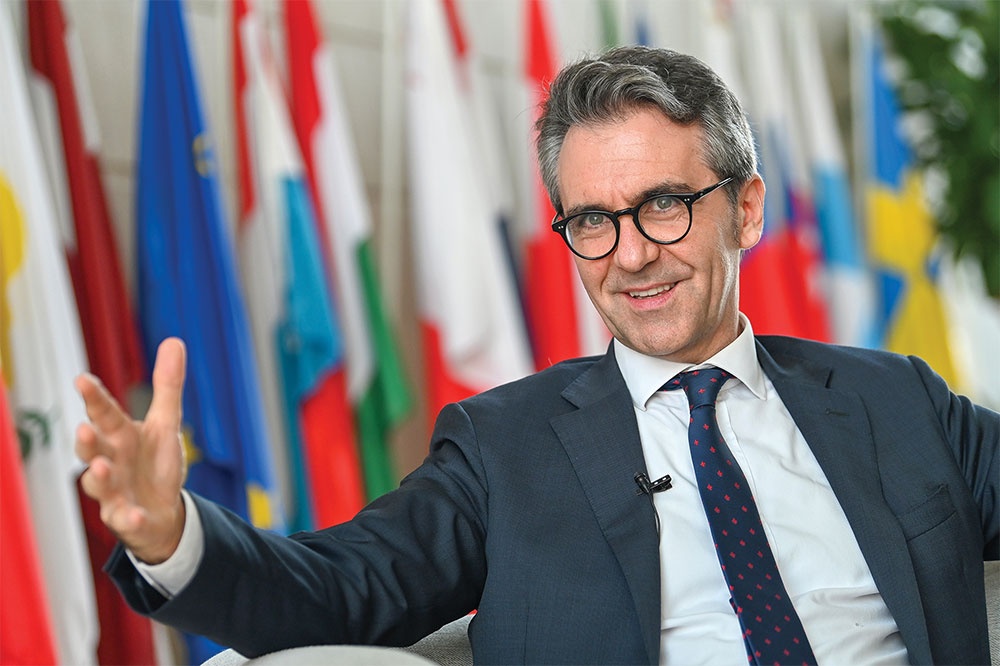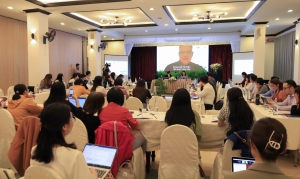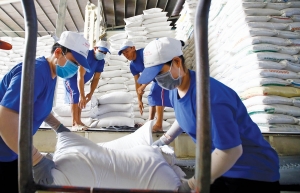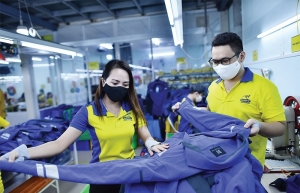Strength to strength in EU relations
I would like to congratulate the Vietnamese government for the excellent performance of the economy in 2022. It is true that in the context of the challenging global economic turbulences, the macroeconomic data for Vietnam looks very promising. Such performance of the Vietnamese economy in 2022 demonstrates good governance and the timely implementation of the macro policies has been appropriate during the post-pandemic period.
 |
| Giorgio Aliberti, Ambassador and Head of the European Union Delegation to Vietnam |
The GDP of Vietnam in 2022 grew 8.02 per cent - the highest GDP growth over the past 10 years - according to the latest data from Vietnam’s General Statistics Office. The inflation was curbed at 3.15 per cent, well below the National Assembly target. The results are quite remarkable that in such a complicated global context, where supply chains are disrupted, the world fuel prices are soaring, and food supplies are in shortage, Vietnam still managed to achieve double-digit growth in exports and a total global trading volume of $732.5 billion last year. The state budget even was in surplus, which is estimated at VND222.5 trillion ($9.67 billion) or 2.3 per cent, and the budget collection increased by almost 20 per cent against planned. I am impressed by this excellent performance.
I firmly believe that the EVFTA has contributed significantly to this success, and the figures speak for themselves. The latest available data sourced from Eurostat indicates a robust growth of the bilateral import-export relations in January-September 2022. The exports of commodities by the EU to Vietnam soared by 18.5 per cent on-year to €9.2 billion ($10 billion) while Vietnam’s exports went up significantly by more than 32 per cent on-year to almost €38 billion ($41.2 billion).
Vietnam has also maintained its leading position as the biggest exporter of commodities among ASEAN countries to the EU market. More impressively, Vietnam has been in the list of 30 biggest exporting economies in the world. Such trend of export growth to the EU will continue, and the country’s target of exporting commodities worth $1 trillion to the world market by 2025 is within the reach of Vietnam when the European consumers continue focusing their attention towards products made here.
A boost in investment
The prospects of bilateral trade between Vietnam and the EU two years after implementation of the EVFTA remain bright despite global uncertainty and complicated political economic situation – and quantified assessments by the Vietnam Chamber of Commerce and Industry (VCCI) about the implementation of the EVFTA prove this point.
Two-way trade after two years of the EVFTA grew to $83.4 billion (averaged at $41.7 billion per year). This represents 24 per cent higher than the average annual bilateral trade value during 2016-2019. The utilisation rate of the agreement by Vietnamese exporters continues to increase as well. Initially, it was 14.8 per cent in 2020, increased to 20.2 per cent in 2021, and to 24.5 per cent in the first six months of 2022, according to a survey of 500 Vietnamese companies by the VCCI.
Many independent analysts hold the view that current global challenges could have wielded far worse impacts on the economy if the important FTAs had not been in place. The EVFTA has acted as a cushion to support the economy of Vietnam in the times of global turbulences.
The picture of investment from the EU into Vietnam appears less upbeat, however, much of it owing to the global complicated political economic context. In 2020, foreign direct investment (FDI) from Europe to Vietnam was $1.38 billion, a decline of 8.6 per cent against 2019. In 2021, FDI increased to 1.41 billion, a slight 2.2 per cent annual increase. The investment bounced back strongly in 2022 where FDI flow from Europe increased significantly to $2.46 billion, a rise of nearly 75 per cent from the year 2021.
Overall, the EVFTA has helped Vietnam to attract more investments from Europe. Nonetheless, the flows of investments from Europe to Vietnam remains quite modest as compared with the potential. Although the EU has been persistently the fifth-biggest investor of Vietnam, such figure was only 0.35 per cent of the EU outward investment in 2021.
Fully aware of this challenge, we have been working closely with the European Chamber of Commerce in Vietnam (EuroCham) and the governmental agencies of Vietnam to promote stronger investment links between the two economies.
The best example of this proactive approach were the successful visits to Vietnam in 2022 of high political representatives of the European Union. In July, Commissioner of Agriculture and Rural Development Janusz Wojciechowski led a market access mission with participation of more than 50 agricultural companies from Europe that explored possibilities of business partnerships with local partners.
And in November, Commissioner for Environment, Oceans, and Fisheries Virginijus Sinkevičius visited Vietnam and met with leaders of the country. He also attended the Green Economy Forum and Exhibition, an international event organised by EuroCham to promote business green initiatives and facilitate partnerships between local and international companies.
Removing barriers
The implementation of the EVFTA, albeit quite successful, certainly has some challenges. Agriculture and pharma are the sectors where we have identified most problems. At present, the EU still has around 60 pending applications for plant and animal products exports to Vietnam, some of them have been waiting for approval since 2014.
Another example is the extension of the validity of the market authorisations for expired pharmaceutical products. Vietnamese people are particularly interested in the good-quality pharmaceutical products from Europe. Nonetheless, the complicated legal procedures and existing practices made it almost impossible for timely imports and distribution of such products.
These unfriendly business procedures fortunately have been gradually removed following the recent revision of laws initiated by the Vietnamese government and National Assembly. Another concern I would like to highlight is the trade facilitation effort, which Vietnam has done quite well in terms of law making but not yet efficiently applied them in practice.
The customs clearance for imported goods has been improved over the past years, but some delays are unavoidable due to the technical requirements and checks at the hand of several agencies. By all means, this will prevent Vietnam and EU-based companies from optimal utilisation of the trade and investment opportunities offered by the EVFTA. The good news is that the Vietnamese government is well aware of such shortcomings and remains open for cooperation with the EU to address these hurdles.
| Examples of benefits for EU exporters from tariff elimination Almost all EU exports of machinery and appliances will be fully liberalised at entry into force of the FTA. - Around half of EU pharmaceutical exports will be duty free immediately and the rest after seven years. - All EU textile exports will be liberalised at entry into force. - Car parts will be duty free after seven years; motorcycles with engines larger than 150 cc will be liberalised after seven years and cars after 10 years except those with large engines (>3000cc for petrol, > 2500cc for diesel) which will be liberalised one year earlier. - Close to 70 per cent of EU chemicals exports will be duty free at entry into force and the rest after three, five and seven years respectively. - Frozen pork meat will be duty free after seven years, dairy products after five years and food preparations after seven years. Chicken will be fully liberalised after 10 years. - As for fisheries, Vietnam has accepted liberalisation at entry into force for salmon, halibut, trout and rock lobster and others after three years. - Wines and spirits will be liberalised after seven years and beer after 10 years. - Vietnam will maintain longer staging for cigarettes as well as existing WTO tariff rate quotas (albeit with reduction of the in-quota rate to zero over 10 years) for raw tobacco, refined sugar, salt and eggs. Examples of EU market access offer to Vietnam EU duties on textile apparel have dismantling periods stretching 5-7 years for the more sensitive items and three years and entry into force for less sensitive goods. Footwear also gets the longest EU staging of seven years for sensitive EU items and three years or entry into force on items which are less sensitive (*). - The EU offered mostly duty-free tariff rate quotas for Vietnamese rice exports: 30,000 tonnes of milled rice; 20,000 tonnes of husked rice; 50 per cent tariff cut for broken rice at entry into force and then linear reduction in five years; 30,000 tonnes of fragrant rice. - Other products which received improved market access via duty-free tariff rate quotas include sweet corn (quota of 5,000 tonnes and liberalisation for baby corn), garlic (quota of 400 tonnes), mushrooms (quota of 350 tonnes), sugar and high-sugar-containing products (combined quota of 20,000 tonnes), manioc starch (quota of 30,000 tonnes), surimi (quota of 500 tonnes) and canned tuna (quota of 11,500 tonnes and EU strict rules of origin). - Liberalisation of non-processed shrimp will be at entry into force; and basa fish will be liberalised in three years. (*) On footwear, Vietnam agreed on a solution based on an ex-out definition, which enables liberalisation of athletic/sports footwear either at entry into force or in three years; the rest of the footwear products will be liberalised in seven yearsSource: Delegation of the EU to Vietnam. |
 | Vietnamese businesses trained in EVFTA’s Rules of Origin Vietnamese businesses had the opportunity to improve their knowledge on Rules of Origin (ROO) and receive useful information from experts to take full advantage of the recent European Union–Vietnam Free Trade Agreement (EVFTA) at a workshop organised by the ARISE+ Vietnam Project. |
 | Taking advantage of EVFTA for imports Thanks to the EVFTA, Vietnamese enterprises have opportunities to increase exports to the EU market and promote imported goods and raw materials from the EU with lower prices. |
 | Maximising the benefits of EVFTA Entered into force in the context of the bilateral development of relations, the EU–Vietnam Free Trade Agreement has brought both positive impacts in many fields. Peter Bernhardt, Dr. Eduardo Austin and Prof. Dr. Konstantinos Athanasiadis of the ARISE+ Vietnam Project explain how Vietnam can face up to the challenges that the country’s private and public sector need to address in the years to come. |
 | Vietnam and Poland ramp up robust economic cooperation Vietnam and Poland continue to promote economic cooperation. Piotr Harasimowicz, chief representative officer at the Polish Investment and Trade Agency, shared with VIR’s Thanh Van about the prospects of partnership between two countries. |
What the stars mean:
★ Poor ★ ★ Promising ★★★ Good ★★★★ Very good ★★★★★ Exceptional
Related Contents
Latest News
More News
- Strengthening supply chains through trade promotions and customs reform (December 24, 2025 | 14:00)
- PM orders investment model for North–South high-speed rail (December 22, 2025 | 17:43)
- LS Eco Energy to invest in Vietnam rare earth sector (December 22, 2025 | 17:31)
- Government moves to establish International Financial Centre (December 21, 2025 | 21:00)
- Vietnam's IFC to target global investment flows (December 21, 2025 | 18:00)
- Two national hospitals expand capacity with new facilities (December 20, 2025 | 09:00)
- Ha Tinh breaks ground on major Vingroup industrial and energy projects (December 19, 2025 | 18:24)
- EVN launches major power infrastructure projects nationwide (December 19, 2025 | 18:17)
- VAL inaugurates second production line to meet domestic animal feed demand (December 19, 2025 | 16:37)
- Sun Group pioneers urban tram system in Phu Quoc (December 19, 2025 | 15:00)

 Tag:
Tag:






















 Mobile Version
Mobile Version